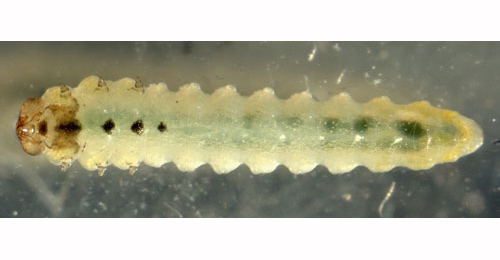|
||||||
|
AREMONIA. Bastard Agrimony. [Rosaceae] |
|
Only one species of Aremonia is recorded in Britain, the introduced Bastard Agrimony (A. agrimonioides). Four British miners are recorded on Aremonia. A key to the European miners recorded on Aremonia is provided in Bladmineerders van Europa. |
|
Key for the identification of the known mines of British |
1a > Leaf-miner: Initially a linear mine which later develops into a conspicuous blotch; frass in two rows in linear section, scattered irregularly in the blotch (Spencer, 1976: 134-5, fig. 237, as potentillae). Corridor, gradually and considerably widening towards the end. Frass in two rows in the corridor part, further up dispersed irregularly. Pupation outside the mine. A short broad upper surface corridor leading to a long blotch between veins. |
|
Agromyza idaeiana (Hardy, 1853) [Diptera: Agromyzidae]. |
1b > Leaf-miner: A long gallery with dispersed frass. Oviposition may be at either side of the leaf, not necessarily close to a vein. The mine is a not very tortuous corridor, not widened in the end. Frass in a broad central line. The mine strongly overlaps with the one of S. splendidissimella. |
|
Stigmella aurella (Fabricius, 1775) [Lepidoptera: Nepticulidae]. |
1c > Leaf-miner: Oviposition on the leaf underside. There starts an initially strongly contorted narrow corridor with a linear interrupted frass line. This is continued in broad corridor or elongated blotch with dispersed frass. Often a number of mines in a leaf. Pupation inside the mine, in a violet to blackish cocoon. |
|
Ectoedemia agrimoniae (Frey, 1858) [Lepidoptera: Nepticulidae]. |
1d > Leaf-miner: Full depth transparent blotch without a clear preceding corridor, quickly and strongly widening from the start. Frass in sausage-shaped granules. Often several leaflets of a composite leaf each have a mine. The larvae of sawflies have at least six thoracic legs (although they may be reduced or absent), a head capsule and chewing mouthparts with opposable mandibles but no abdominal legs. |
 Fenella nigrita larva Image: © Willem Ellis (Bladmineerders van Europa) |
|
Fenella nigrita Westwood, 1839 [Hymenoptera: Tenthredinidae]. |
| Last updated 30-Jun-2019 Brian Pitkin | ||
